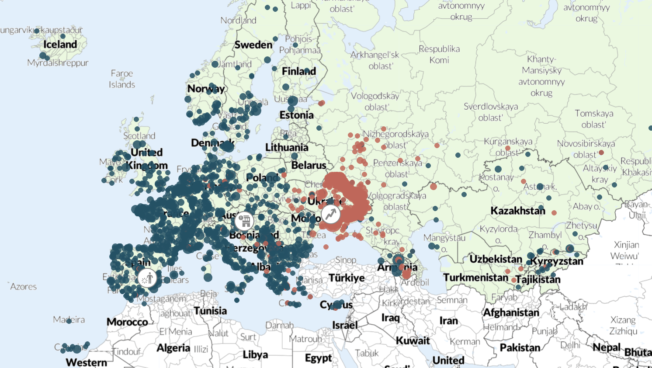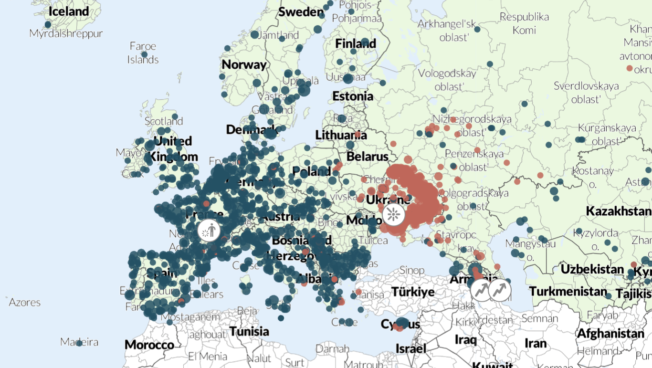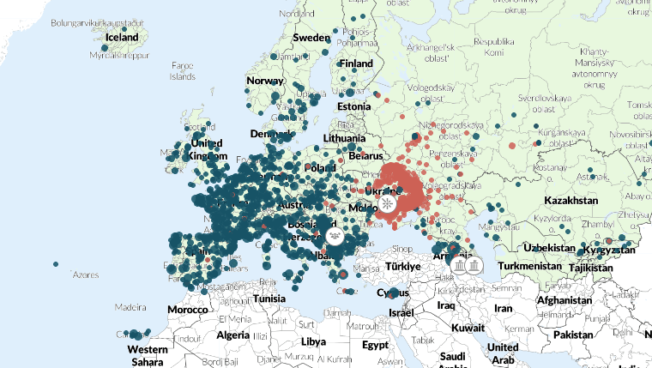Regional Overview
Europe and Central Asia
April 2025
Posted: 3 April 2025
In this Regional Overview covering April 2025
- Armenia-Azerbaijan: Competing allegations of gunfire resume as sides inch closer to a peace deal
- Russia: Ukrainian forces lose their foothold in Kursk but scale up long-range attacks
- Serbia: Government increases pressure on anti-corruption demonstrators
- Ukraine: Russia re-opens Zaporizhia front, targets Sumy
Armenia-Azerbaijan: Competing allegations of gunfire resume as sides inch closer to a peace deal
On 13 March, Armenia’s foreign ministry announced it accepted Azerbaijan’s proposals on outstanding articles of the pending peace treaty between the two countries.1Ministry of Foreign Affairs of Armenia, “MFA Statement,” 13 March 2025 Despite Armenia’s stated willingness to proceed with signing at the earliest opportunity, Azerbaijan continued to insist on amending Armenia’s Constitution to remove references to Artsakh2The disputed territory of Nagorno-Karabakh is internationally recognized as part of Azerbaijan. ACLED refers to the former de facto state and its defunct institutions in the hitherto ethnic Armenian majority areas of Nagorno-Karabakh as Artsakh — the name by which the de facto territory used to refer to itself. For more on methodology and coding decisions around de facto states, see the methodology primer about Central Asia and the Caucasus on ACLED’s Knowledge Base. — which Azerbaijan reconquered in 2023, prompting the exodus of its entire ethnic Armenian population. Azerbaijan also demands the disbanding of the Organization for Security and Co-operation in Europe Minsk Group, co-chaired by France, Russia, and the United States, which had previously overseen Armenia-Azerbaijan negotiations.3Republic of Azerbaijan Ministry of Foreign Affairs, “Statement on conclusion of the negotiations on the text of the draft Agreement on Peace and the Establishment of Interstate Relations between Azerbaijan and Armenia,” 13 March 2025
In the days that followed the announcement, Azerbaijan alleged that over 20 instances of gunfire from Armenian positions targeted its armed forces, marking the most serious escalation since April 2024. In recent months, Azerbaijani allegations primarily concerned its Nakhchivan exclave, to which it seeks a land link via Armenia. In contrast, the most recent Azerbaijani-alleged ceasefire breaches targeted Azerbaijani positions within Armenia proper, which Azerbaijan seized during its September 2022 invasion in the aftermath of the second war over Artsakh. Starting on 21 March, Armenian sources issued about 10 counter-claims of Azerbaijani gunfire toward Armenia’s eastern regions of Syunik and Gegharkunik. Observers note Azerbaijan may be reluctant to sign off on the peace treaty even if Armenia were to swiftly amend its constitution, but the odds of renewed fighting may be lower despite the presence of signs of an escalation.4Nate Ostiller, “Armenia and Azerbaijan agreed on peace — so why do they seem headed for war?” Open Caucasus Media, 25 March 2025
Russia: Ukrainian forces lose their foothold in Kursk but scale up long-range attacks
On 12 March, Russian forces recaptured the town of Sudzha, a district center in Russia’s Kursk region held by Ukraine since August 2024. The recapture came after Russia mounted a weeks-long campaign to disrupt Ukrainian supply lines during which they blew up bridges and staged an incursion into Ukrainian forces’ rear in the town via a non-operational gas pipeline that used to pump Russian natural gas westward. The operation coincided with a week-long pause in US military aid and intelligence sharing.5Daphne Psaledakis and Pesha Magid, “US to resume security support to Ukraine as Kyiv says it is ready to accept ceasefire proposal,” Reuters, 12 March 2025 Ukrainian forces also withdrew from another 18 settlements in the area without a fight, avoiding an encirclement but holding on to heights on the Russian side of the border to stave off a Russian re-invasion of Ukraine’s own Sumy region. Likely aiming to tie up and spread Russian forces thin in the area as well as to preclude redeployments to other areas in Ukraine, they also invaded a border area further south in Russia’s Belgorod region. The collapse of Ukraine’s Kursk campaign rendered moot Ukrainian President Volodymyr Zelenskyy’s proposal to exchange occupied territories as part of a truce.6Shawn Walker, “Zelenskyy: Europe cannot guarantee Ukraine’s security without America,” The Guardian, 11 February 2025
Meanwhile, on 11 March, Russian forces claimed to have intercepted over 300 Ukrainian drones in 12 regions, which is the largest Ukrainian strike package since the beginning of Russia’s war against Ukraine.7Volodymyr Ivanyshyn and Martin Fornusek, “Moscow targeted by largest drone strike in war, over 330 UAVs downed across Russia, authorities claim,” The Kyiv Independent, 11 March 2025; Agentstvo Media, “Ukraine carried out an unprecedented attack for this war by drones on the day of the beginning of negotiations between Kyiv and Washington in Saudi Arabia,” 11 March 2025 Some of the drones may have reached their targets nonetheless, resulting in at least three civilian fatalities in Moscow suburbs that normally enjoy enhanced air defense cover8Valeriy Shiryaev, “Uncrewed Threat,” Novaya Gazeta, 4 September 2024 and disrupting the flow of Russian oil to Hungary via the “Druzhba” pipeline. On 14 March, Ukrainian forces may have also battle-tested their Neptune-M missile9Veronika Melkozerova, “Ukraine’s long-range Neptune cruise missile is a potential trump card,” Politico, 20 March 2025 to hit an oil refinery in Tuapse in the Krasnodar region, setting it ablaze for three days. Strikes on Russian oil and gas infrastructure persisted throughout the month despite the US-mediated moratorium agreed on 18 March10President of Russia, “Telephone conversation with President of the United States Donald Trump,” 18 March 2025; Karoline Leavitt, “President Donald J. Trump’s Call with President Vladimir Putin,” U.S. Embassy & Consulates in Russia, 18 March 2025 and refined on 25 March,11President of Russia, “A list of energy facilities of Russia and Ukraine covered by the temporary moratorium on strikes against the energy system, as agreed upon by the Russian and American side,” 25 March 2025 including repeated targeting of the Caspian Pipeline Consortium facilities in the Krasnodar region and the complete destruction of the gas metering station near Sudzha. In addition, on 20 March, Ukrainian drones struck the Engels-2 airbase near Saratov, allegedly destroying a stock of Russian cruise missiles used to bomb Ukraine.12David Axe, “The Triple Tap Raid On the Engels Bomber Base Cost Russia $960 Million,” Forbes, 27 March 2025
Serbia: Government increases pressure on anti-corruption demonstrators
Student and teacher-led demonstrations against systemic corruption in Serbia became increasingly tense in March, despite the number of associated events dropping by more than a third since their peak in February. The demonstrations were triggered by the deadly railway station canopy collapse last November in Novi Sad. On 10 March, several hundred students blocked the headquarters of Radio Television of Serbia, the national broadcaster, accusing it of editorial bias. Police dispersed the crowd after 22 hours, seriously injuring a plainclothed police officer in the process. Over 300,000 people converged in Belgrade on 15 March — one of the largest rallies in Serbia’s recent history.13Guy De Launey, “Serbia’s largest-ever rally sees 325,000 protest against government,” BBC, 16 March 2025 Police allegedly used a banned long-range acoustic device to disperse the crowd during the 15-minute silent ceremony to honor the 15 victims of the incident in Novi Sad, causing hundreds of injuries among participants. The government denied using the device but admitted to owning one.14N1 Belgrade, “Dacic displays LRAD devices,” N1, 19 March 2025
The state and its proxies have also increasingly targeted activists outside of demonstrations. In March, ACLED records increased targeting of students and teachers spearheading the anti-corruption demonstrations independently of the opposition, with at least eight attacks by suspected supporters of the ruling Serbian Progressive Party (SNS) party. There was also one attack against an SNS affiliate. Furthermore, in the run-up to the Belgrade rally, police detained and charged several opposition members and activists with plotting a Western-backed coup.15Jovana Gec and Dusan Stojanovic, “Over 100,000 people join protest rally in Belgrade against Serbia’s president and government,” Associated Press, 15 March 2025
While the student and teachers’ demonstrations have avoided association with the established opposition, opposition members in parliament pressed for a temporary caretaker government. On 4 March, several MPs threw smoke grenades to disrupt a session during which SNS aimed to pass new legislation, which the opposition deemed contrary to the government’s caretaker role in the wake of the resignation of Prime Minister Miloš Vučević. Wary of calling an early election to break the stalemate, the SNS announced a three-day pro-government rally in Belgrade in April, in addition to allowing an encampment in Belgrade by SNS-friendly students demanding the resumption of studies at universities and cutting teachers’ pay to force them back to work.16Sanja Kljajic, “Could Serbia’s student protests bring down the government?” Deutsche Welle, 14 March 2025; Vreme, “Nothing from Vučić’s rally on March 28: A new announcement has arrived for the three-day celebration of the president,” 27 March 2025; Katarina Baletic and Aleksandra Reves, “News Serbians Join ‘General Strike’, Angry at Protesting Teachers’ Pay Cuts,” Balkan Insight, 7 March 2025
Ukraine: Russia re-opens Zaporizhia front, targets Sumy
In contrast to recovering land in Kursk (see the section on Russia above), Russian forces’ advances in Ukraine in March were far less certain. They stalled around Pokrovsk and Toretsk in the Donetsk region in March, despite the number of battles climbing to levels previously seen between July 2024 and January 2025. Probably betting on the chronic shortage of personnel on the Ukrainian side of the frontline, Russia resumed its offensive in the Zaporizhia region, where the number of battles increased by over 60%. As a result, Russian forces occupied five settlements southwest of Ukraine-held Orikhiv. Elsewhere, the pace of Russian occupation in terms of seized settlements continued the downward trend noted in February.
Meanwhile, the number of Russian attacks against civilians slightly increased in March to a level last seen in October 2024. The increase was especially felt in the Sumy region where their number grew by a third in light of the showdown in Kursk on the other side of the border. A Russian missile strike on Sumy city on 24 March alone injured over 100 civilians, including 23 children. Meanwhile, Russia rejected the US-proposed blanket ceasefire accepted by Ukraine but agreed to a moratorium on strikes on energy infrastructure17Jeff Mason and Joseph Ax, “Putin agrees to 30-day halt on energy facility strikes but no full Ukraine ceasefire,” Reuters, 19 March 2025 — which continued nevertheless: ACLED records at least five Russian strikes between 18 and 25 March that led to blackouts in areas unaffected by combat, including in the Odesa, Mykolaiv, Kherson, and Poltava regions. Russia also conditioned a ceasefire on the Black Sea with sanction relief.18President of Russia, “Main outcomes of the Russia and United States expert groups meeting,” 25 March 2025 In addition, Russia’s President Vladimir Putin demanded regime change in Kyiv and expressed confidence that his forces will overwhelm Ukrainian troops in the long run as US military aid offered by the Biden administration is set to dwindle in the second quarter.19Agence France Presse, “Putin Calls To Remove Zelensky, ‘Finish Off’ Ukrainian Troops,” 28 March 2025
For more information, see the ACLED Ukraine Conflict Monitor and ACLED’s latest report, Bombing into submission: Russian targeting of civilians and infrastructure in Ukraine.
See More
See the Codebook and the User Guide for an overview of ACLED’s core methodology. For additional documentation, check the Knowledge Base. Region-specific methodology briefs can be accessed below.
Links:
For additional resources and in-depth updates on the conflict in Ukraine, check our dedicated Ukraine Confict Monitor.







